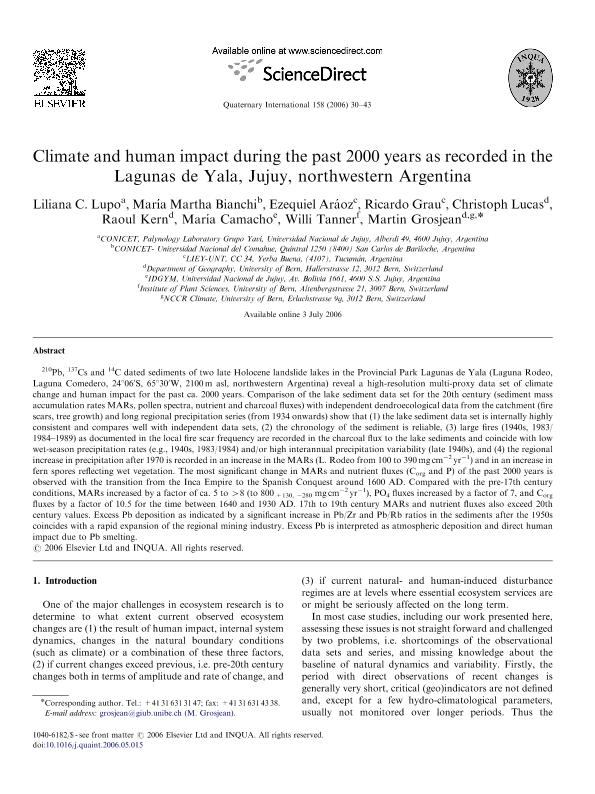Mostrar el registro sencillo del ítem
dc.contributor.author
Lupo, Liliana Concepcio
dc.contributor.author
Bianchi, Maria Martha

dc.contributor.author
Aráoz, Ezequiel

dc.contributor.author
Grau, Hector Ricardo

dc.contributor.author
Lucas, Christoph
dc.contributor.author
Kern, Raoul
dc.contributor.author
Camacho, María
dc.contributor.author
Tanner, Willi
dc.contributor.author
Grosjean, Martin
dc.date.available
2020-10-14T17:34:59Z
dc.date.issued
2006-12
dc.identifier.citation
Lupo, Liliana Concepcio; Bianchi, Maria Martha; Aráoz, Ezequiel; Grau, Hector Ricardo; Lucas, Christoph; et al.; Climate and human impact during the past 2000 years as recorded in the Lagunas de Yala, Jujuy, northwestern Argentina; Pergamon-Elsevier Science Ltd; Quaternary International; 158; 1; 12-2006; 30-43
dc.identifier.issn
1040-6182
dc.identifier.uri
http://hdl.handle.net/11336/115904
dc.description.abstract
210Pb, 137Cs and 14C dated sediments of two late Holocene landslide lakes in the Provincial Park Lagunas de Yala (Laguna Rodeo, Laguna Comedero, 24°06′S, 65°30′W, 2100 m asl, northwestern Argentina) reveal a high-resolution multi-proxy data set of climate change and human impact for the past ca. 2000 years. Comparison of the lake sediment data set for the 20th century (sediment mass accumulation rates MARs, pollen spectra, nutrient and charcoal fluxes) with independent dendroecological data from the catchment (fire scars, tree growth) and long regional precipitation series (from 1934 onwards) show that (1) the lake sediment data set is internally highly consistent and compares well with independent data sets, (2) the chronology of the sediment is reliable, (3) large fires (1940s, 1983/1984-1989) as documented in the local fire scar frequency are recorded in the charcoal flux to the lake sediments and coincide with low wet-season precipitation rates (e.g., 1940s, 1983/1984) and/or high interannual precipitation variability (late 1940s), and (4) the regional increase in precipitation after 1970 is recorded in an increase in the MARs (L. Rodeo from 100 to 390 mg cm-2 yr-1) and in an increase in fern spores reflecting wet vegetation. The most significant change in MARs and nutrient fluxes (Corg and P) of the past 2000 years is observed with the transition from the Inca Empire to the Spanish Conquest around 1600 AD. Compared with the pre-17th century conditions, MARs increased by a factor of ca. 5 to >8 (to 800 +130, -280 mg cm-2 yr-1), PO4 fluxes increased by a factor of 7, and Corg fluxes by a factor of 10.5 for the time between 1640 and 1930 AD. 17th to 19th century MARs and nutrient fluxes also exceed 20th century values. Excess Pb deposition as indicated by a significant increase in Pb/Zr and Pb/Rb ratios in the sediments after the 1950s coincides with a rapid expansion of the regional mining industry. Excess Pb is interpreted as atmospheric deposition and direct human impact due to Pb smelting. © 2006 Elsevier Ltd and INQUA.
dc.format
application/pdf
dc.language.iso
eng
dc.publisher
Pergamon-Elsevier Science Ltd

dc.rights
info:eu-repo/semantics/openAccess
dc.rights.uri
https://creativecommons.org/licenses/by-nc-sa/2.5/ar/
dc.subject.classification
Antropología, Etnología

dc.subject.classification
Sociología

dc.subject.classification
CIENCIAS SOCIALES

dc.title
Climate and human impact during the past 2000 years as recorded in the Lagunas de Yala, Jujuy, northwestern Argentina
dc.type
info:eu-repo/semantics/article
dc.type
info:ar-repo/semantics/artículo
dc.type
info:eu-repo/semantics/publishedVersion
dc.date.updated
2019-09-13T14:51:35Z
dc.journal.volume
158
dc.journal.number
1
dc.journal.pagination
30-43
dc.journal.pais
Estados Unidos

dc.description.fil
Fil: Lupo, Liliana Concepcio. Consejo Nacional de Investigaciones Científicas y Técnicas; Argentina. Universidad Nacional de Jujuy; Argentina
dc.description.fil
Fil: Bianchi, Maria Martha. Consejo Nacional de Investigaciones Científicas y Técnicas; Argentina. Universidad Nacional del Comahue; Argentina
dc.description.fil
Fil: Aráoz, Ezequiel. Consejo Nacional de Investigaciones Científicas y Técnicas; Argentina. Universidad Nacional de Tucumán. Facultad de Ciencias Naturales e Instituto Miguel Lillo. Laboratorio de Investigaciones Ecológicas de las Yungas; Argentina
dc.description.fil
Fil: Grau, Hector Ricardo. Universidad Nacional de Tucumán. Facultad de Ciencias Naturales e Instituto Miguel Lillo. Laboratorio de Investigaciones Ecológicas de las Yungas; Argentina. Consejo Nacional de Investigaciones Científicas y Técnicas; Argentina
dc.description.fil
Fil: Lucas, Christoph. University of Bern; Suiza
dc.description.fil
Fil: Kern, Raoul. University of Bern; Suiza
dc.description.fil
Fil: Camacho, María. Universidad Nacional de Jujuy; Argentina
dc.description.fil
Fil: Tanner, Willi. University of Bern; Suiza
dc.description.fil
Fil: Grosjean, Martin. University of Bern; Suiza
dc.journal.title
Quaternary International

dc.relation.alternativeid
info:eu-repo/semantics/altIdentifier/doi/http://dx.doi.org/10.1016/j.quaint.2006.05.015
dc.relation.alternativeid
info:eu-repo/semantics/altIdentifier/url/https://www.sciencedirect.com/science/article/abs/pii/S1040618206001522
Archivos asociados
